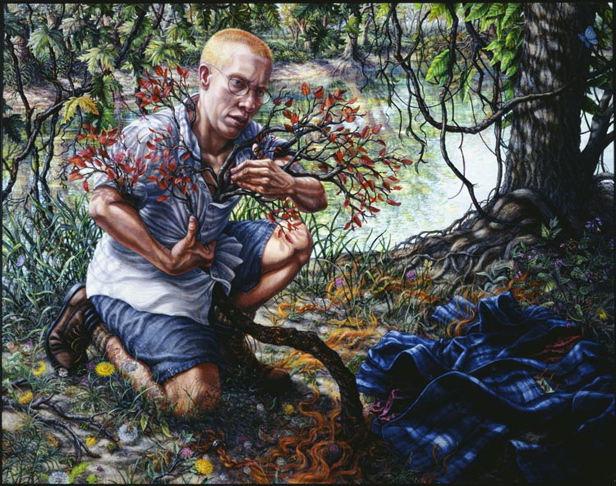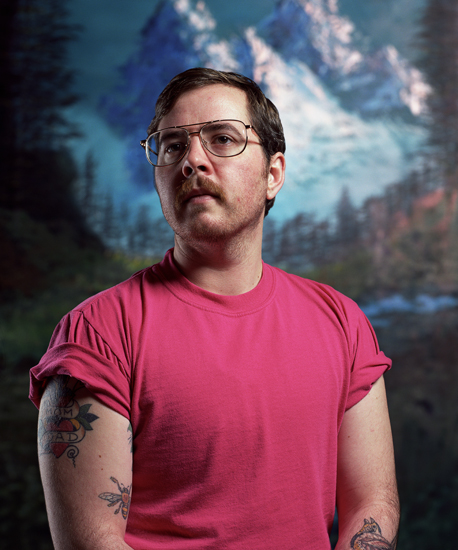Serendip is an independent site partnering with faculty at multiple colleges and universities around the world. Happy exploring!
Notes Towards Day 3 (Wed, Jan. 29): Transporting

 |
 |
Riva Lehrer's Circle Stories, and (vs?) Lorenzo Triburgo's Transportraits
10-2 this Friday we will be taking our second field trip, to the John Heinz National Wildlife Refuge at Tinicum.
Be @ Pem Arch a bit before 10 on Friday morning; don't leave w/out David or your lunches!
(Betsy & Lisa all set for pick up?)
There are two on-line resources you might look @ (on Ava's syllabus, and in "this week's work"):
one a description of the refuge,
another a Philadelphia Inquirer story about the racial history of the neighborhood:
a riot that was provoked, in 1963, among the white neighbors, when a black family moved in.
Ava will join us for the last 1/2 an hour of class today, to help us prepare for the field trip,
and give you instructions for observing, recording, gathering there.
Reminder: her public lecture is @ 7 p.m. tomorrow night, in the Lecture Hall.
I'll describe your homework for this class @ the end of our session
(when it will make more sense). Remind me if Ava arrives and I forget...
II. On Monday, I asked you to create an image, to imagine an avatar for bell hooks.
We didn't get the time to do the same for Eli Clare--but
here the avatar he selected for his webpage. It is part of a painting of him by Riva Lehrer:

Write for five minutes about what you see here--
focus especially on the two categories Eli uses to organize this book: I. Place and II. Body:
what do you see of each? how can you describe the relationship between them?
(You won't have to read this, though we will talk about what we've written-and-seen...)
On his website, Eli describes the image as "me embracing, wrestling with a tree, taking it into me
and at the same time giving something of myself back"--i.e. very ecological! So, too, is
Riva's description of her project of Circle Stories.
III. Now, look @ the series of Transportraits by Lorenzo Triburgo,
focusing again on the same two categories, Place and Body:
what do you see of each?
how can you describe the relationship between them?
What have you seen?
Triburgo's description of what he was doing:
I have created a series of unlikely heroic portraits that examine representations of American masculinity, using transgender men set against a created environment. Following the path of 19th century portrait and landscape artists such as John Singer Sargent and Alfred Jacob Miller, I simultaneously reference classic and contemporary photographic portraiture and consider the origination of American male identity.
...I created oil-painted landscapes....The backdrop sets the stage for a series of portraits focusing on a population that is rarely celebrated in a laudable manner. The photographs...draw a parallel between the (mis)perception of the 'photographic record' devoid of social construct and gender as an unchanging truth. In Transportraits I invite the viewer to question the construct of portraiture (and masculinity) while simultaneously depicting a sincere heroism.
IV. All this as "warm-up," to lead us back to Exile and Pride,
and its portrait of the relationship of the (transgendered, disabled, working class) self
to his environment. I considered assigning only Part I of the book for this class.
Does it make sense that we read Part II? Did you wonder (as Kelsey wondered, when
reading Freire) why you were reading it? What do "bodies" have to do w/ "eco-literacy"?
An unusual form for a memoir: to put the setting first, bring it into the foreground.
The book as a whole is dedicated "To the rocks and trees, hills and beeches."
What's the effect of doing that? What happens to the self,
when the issues of gender and disability and class are contextualized in this way?
"My loss of home is about being queer" (p. 35).
"My loss of home, of exile, is about class" (p. 37).
Clare repeats the refrain "The body as home" five times over 3 pages in Exile and Pride (pp. 11-13):
"The body as home, but only if it is understood that bodies are never singular,
but rather haunted, strengthened, underscored by countless other bodies."
"The body as home, but only if it is understood that
place and community and culture burrow deep into our bones."
"The body as home, but only if it is understood that language too lives under the skin."
"The body as home, but only if it is understood that bodies can be stolen,
fed poison and lies, torn away from us."
"The body as home, but only if it is understood that the stolen body can be reclaimed."
What does it mean to call our bodies [rather than a place] home?
V. This weekend, I would like you to read two essays about home, written by your classmates
(you'll see your assignments, in my comments to your own essay, hopefully tomorrow!); then,
in your Sunday night posting, reflect on where you see evidence of "exile" in 3 essays about "home"-->
look for the "cracks," the "displacements," the places where the writer testifies to her homelessness.
Be sure to use usernames, in referencing your classmates on-line....
AND MAKE ALL THESE PRIVATE POSTS.
We will also take some time on Monday to talk in threesomes w/ one another about our essays (bring copies!)
For Monday, please also read two theoretical essays that complexify our investment in
home--and the usefulness of "home" and "place" as a starting place for ecological work.
They will question some of y/our shared presumptions about "home."
Both are in my protected reading file on Serendip, which you can access only when you are logged in:
Biddy Martin and Chandra Mohanty's 1986 essay, "Feminist Politics: What's Home Got to Do with It?"
and a chapter from Timothy Morton's 2010 book, The Ecological Thought.....
We'll talk further about
* what we need to make a home,
* what "multi-issue politics might make [your] home possible," and in particular about
* how locating ourselves @ home--or away from home/in exile--
might be useful in the work we are doing here/ in environmental action.
VI. 3:30: Ava arrives to prepare us for our trip to Tinicum

